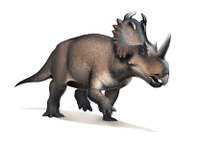Post by dinosauria101 on Apr 13, 2019 3:32:49 GMT 5
Styracosaurus albertensis
Styracosaurus (meaning "spiked lizard" from the Ancient Greek styrax/στύραξ "spike at the butt-end of a spear-shaft" and sauros/σαῦρος "lizard") is a genus of herbivorous ceratopsian dinosaur from the Cretaceous Period (Campanian stage), about 75.5 to 75 million years ago. It had four to six long parietal spikes extending from its neck frill, a smaller jugal horn on each of its cheeks, and a single horn protruding from its nose, which may have been up to 60 centimetres (2.0 feet) long and 15 centimetres (5.9 inches) wide. The function or functions of the horns and frills have been debated for many years. Styracosaurus was a relatively large dinosaur, reaching lengths of 5.5 metres (18 feet) and weighing nearly 3 tonnes. It stood about 1.8 meters (5.9 feet) tall. Styracosaurus possessed four short legs and a bulky body. Its tail was rather short. The skull had a beak and shearing cheek teeth arranged in continuous dental batteries, suggesting that the animal sliced up plants. Like other ceratopsians, this dinosaur may have been a herd animal, travelling in large groups, as suggested by bonebeds.![]()

Centrosaurus apertus
Centrosaurus (/ˌsɛntroʊˈsɔːrəs/ SEN-tro-SAWR-əs) is a genus of herbivorous ceratopsian dinosaurs from the Late Cretaceous of Canada. Their remains have been found in the Dinosaur Park Formation, dating from 76.5 to 75.5 million years ago.The massive bodies of Centrosaurus were borne by stocky limbs, although at up to 5.5 metres (18 ft) they were not particularly large dinosaurs.[2] Like other centrosaurines, Centrosaurus bore single large horns over their noses.[3] These horns curved forwards or backwards depending on the specimen. Skull ornamentation was reduced as animals aged.[4] The frill was relatively short compared to the total skull length, and could grow to over half a meter (68.8 cm) long in the oldest and largest adults.[4]Centrosaurus is distinguished by having two large hornlets which hook forwards over the frill. A pair of small upwards directed horns is also found over the eyes. The frills of Centrosaurus were moderately long, with fairly large fenestrae and small hornlets along the outer edges.[3]

Credit to Wikipedia
Styracosaurus (meaning "spiked lizard" from the Ancient Greek styrax/στύραξ "spike at the butt-end of a spear-shaft" and sauros/σαῦρος "lizard") is a genus of herbivorous ceratopsian dinosaur from the Cretaceous Period (Campanian stage), about 75.5 to 75 million years ago. It had four to six long parietal spikes extending from its neck frill, a smaller jugal horn on each of its cheeks, and a single horn protruding from its nose, which may have been up to 60 centimetres (2.0 feet) long and 15 centimetres (5.9 inches) wide. The function or functions of the horns and frills have been debated for many years. Styracosaurus was a relatively large dinosaur, reaching lengths of 5.5 metres (18 feet) and weighing nearly 3 tonnes. It stood about 1.8 meters (5.9 feet) tall. Styracosaurus possessed four short legs and a bulky body. Its tail was rather short. The skull had a beak and shearing cheek teeth arranged in continuous dental batteries, suggesting that the animal sliced up plants. Like other ceratopsians, this dinosaur may have been a herd animal, travelling in large groups, as suggested by bonebeds.

Centrosaurus apertus
Centrosaurus (/ˌsɛntroʊˈsɔːrəs/ SEN-tro-SAWR-əs) is a genus of herbivorous ceratopsian dinosaurs from the Late Cretaceous of Canada. Their remains have been found in the Dinosaur Park Formation, dating from 76.5 to 75.5 million years ago.The massive bodies of Centrosaurus were borne by stocky limbs, although at up to 5.5 metres (18 ft) they were not particularly large dinosaurs.[2] Like other centrosaurines, Centrosaurus bore single large horns over their noses.[3] These horns curved forwards or backwards depending on the specimen. Skull ornamentation was reduced as animals aged.[4] The frill was relatively short compared to the total skull length, and could grow to over half a meter (68.8 cm) long in the oldest and largest adults.[4]Centrosaurus is distinguished by having two large hornlets which hook forwards over the frill. A pair of small upwards directed horns is also found over the eyes. The frills of Centrosaurus were moderately long, with fairly large fenestrae and small hornlets along the outer edges.[3]

Credit to Wikipedia


